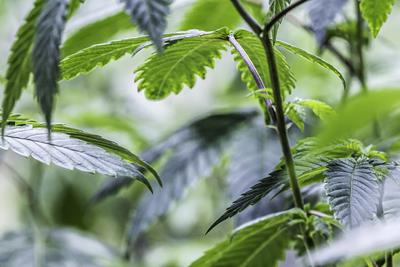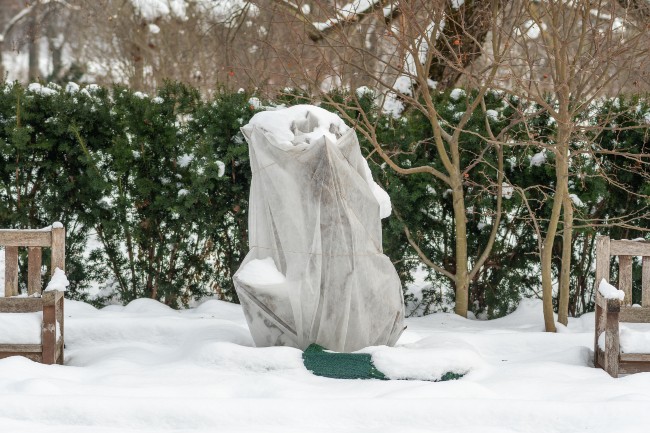
Friday January 7, 2022
By Trevor Ross
 Growing
Growing
Growing cannabis outdoors is great; nothing quite compares to naturally grown marijuana heated by the sun and watered by the rain. However, those same elements that benefit the plant may also harm it. Severe sunlight can cook plants, and cold temperatures can stunt or freeze them. Hard wind and rain can break leggy limbs, and so can snow and hail. Despite these dangers, the full spectrum of sunlight over a full growing season gives marijuana a more complete terpene profile, and rainwater collects nitrogen from the atmosphere that encourages growth, particularly in the vegetative stage.
What can be done then to protect outdoor cannabis and reap these natural rewards? In this article, we review how extreme heat, cold, and other violent weather may affect cannabis, and how to protect marijuana plants outside.
How to Protect Cannabis Plants from Outdoor Heat
Like most plants, cannabis breathes through pores in the leaves called “stoma.” When stomata open to take in carbon dioxide, they simultaneously lose water vapor. Therefore, plants suffering heat stress will curl their leaves to minimize their stomata’s exposure to hot air in an effort to minimize water loss. So if you ever see curling leaves, water the plant immediately.
Of course, the best solution to any problem on this list is prevention. Just as with human health, matters of plant health are always easier and cheaper to prevent than they are to treat or cure.
Prevent water loss first by minimizing evaporation. This can be done by watering in the early morning so the plant can drink it’s fill before the temperature rises, and by mulching.Mulching is the process of covering the soil in organic material like straw or grass clippings (note: hay has seeds in it, and bark or wood chips will lower soil pH, so try to avoid these). Mulching keeps the surface soil cool, protecting shallow roots from heat, and further prevents moisture from evaporating when the sun rises. Watering at night is not advised because cooler temperatures allow water to pool and stagnate, inviting mold growth.
For plants that need a break from the heat, garden cloth can be stretched into shades or canopies held aloft with sticks, stakes, or strung between other anchors like trees. If you can’t anchor a shade anyplace, consider growing in containers like grow bags. Especially when placed on a wheeled caddy, container gardening allows growers to move plants in and out of the sun and rain. Cloth bags are recommended because they are more breathable than plastic or clay pots, and offer thorough drainage.
How to Protect Cannabis Plants from Cold and Frost
Most cannabis strains are well adapted to heat, and some are even cold-resistant, but none are frost or ice resistant. Even one surprise frost in October can scuttle an adult cannabis plant.
Frost is the freezing of surface moisture, and when those crystals of ice coat tender plant matter like leaves and flowers, it freezes the cellular moisture just below the surface as well, killing the affected cells. This kind of damage is irreversible, and when it happens across much of the surface of the plant, it can be enough to kill it.

The easiest way to keep plants warm is to get them inside. If that’s not possible, you may be tasked with setting up a makeshift structure to keep them warm. Gardening burlap can be used to cover plants, but don’t throw the whole weight onto the plant.
Metal poles or bamboo stakes can be used as corners to wrap burlap or other coverings around your plants, and PVC poles are used in hoop houses to pull plastic sheets over plants in winter.
How to Protect Cannabis from Wind and Rain
Harvest season in many areas brings heavier and more frequent rainfall. This is less of a problem in the summer when warm temperatures quickly dry plants. However, as temperatures fall along with rain, water pools and stagnates in the deep grooves of cannabis buds, creating ideal conditions for mold. Solutions like covering your plants or keeping them mobile will both help in rainy conditions. The least you can do is to gently shake your plants dry after a rain to give them half a chance at drying out. But if you live in a wet climate like the Pacific Northwest, consider cultivating mold-resistant strains like Northern Lights or The Church.
Heavy rainfall can also wash away much of the soil, so growers are encouraged to pile extra soil around plants to prevent roots from becoming exposed.
Strong winds can affect growers in almost any climate, and while most cannabis plants can withstand some pressure, storms may require a shield or windbreak. This can be achieved similar to cold weather coverings, with garden burlap erected around your plants. A quick search of “DIY windbreaks” will reveal a host of other designs using cheap or scrap material. Strong winds may take a few branches, but overall it is less of a threat than extreme heat or cold.
Summary
Cannabis plants love warm weather but are still susceptible to severe heat. The first sign of heat stress in cannabis plants is that their leaves will curl. This is a water saving strategy employed to minimize the water vapor lost through the stoma in their leaves. If your plant is curling in the heat, water it immediately. Additional measures can be taken by mulching the soil to keep it cool and prevent all the water from evaporating, and by watering in the morning, before temperatures rise.
Freezing temperatures are a serious threat to even healthy, mature plants. Frost on a cannabis plant can freeze the cells just below the epidermis, killing them and causing irreversible damage. Snow will further freeze and weigh down a plant, and hail will pummel them. Protect plants from freezing temperatures ideally by moving them inside. Failing that, a structure may need to be built or wrapped around them. Gardening burlap and other outdoor cloth are wrapped around plants in colder climates.

Wind is less of a threat, but stormy conditions may require a temporary shield or windbreak. Heavy rainfall can be more of a problem by weighing down branches and washing away soil. Be sure to pile extra soil around the base of the plant to protect the root ball from exposure.
What makes cold weather more threatening is that it’s often encountered near the end of the growing process, when the valuable buds are almost done maturing. Check your forecast every day, and if an early frost threatens your area, don’t risk months of work for one more day on the vine; get your plants harvested or moved inside immediately. A premature harvest is better than a lost harvest. Also, always remember to remove any structure or objects placed atop your plants as soon as the danger has passed. If you’re curious about growing in your state, check out our Cannabis Cultivation Laws: State-by-State Marijuana Growing Guide.
FAQs
What nutrients do I need for growing cannabis outdoors?
Outdoor marijuana requires the same nutrients as indoor. The primary macronutrients; nitrogen (N), phosphorus (P), and potassium (K), as well as micronutrients like iron, magnesium, and sulfur will be required throughout the growing process.
Can you grow Autoflowers outside?
Yes.
While photoperiod plants rely on seasonal sunlight to switch from the vegetative stage to flowering, autoflowering plants switch after a certain amount of time regardless of the light schedule.
Do you have tips for protecting cannabis plants from outdoor elements? We’d love to hear about them in the comments below!







